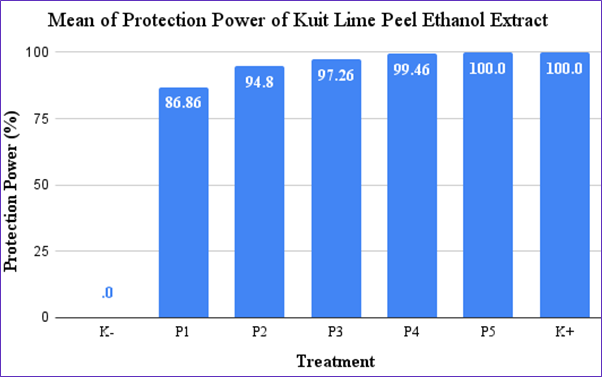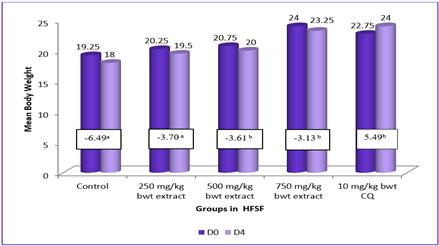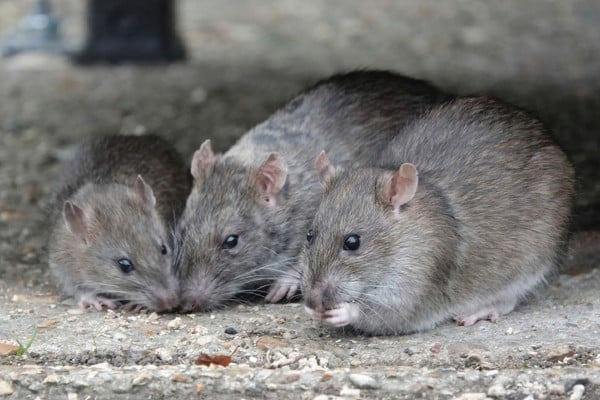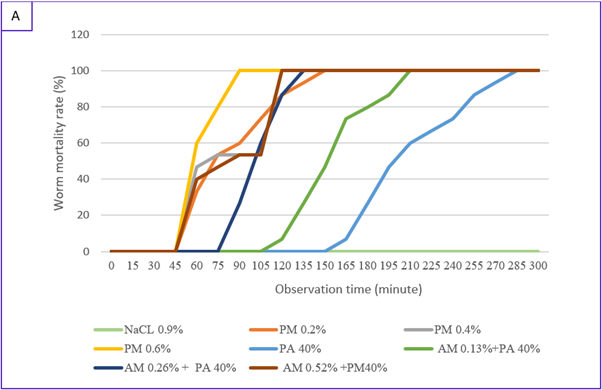Repellent Power of Kuit Lime Peel Ethanol Extract (Citrus amblycarpa L.) Against Aedes aegypti Mosquitoes

Downloads
This research investigated the capability of the kuit lime peel ethanol extract as a repellent against Aedes aegypti mosquitoes. This study used the post test only control group design approach and the experimental method recommended by the World Health Organization Pesticides Evaluation Scheme (WHOPES) with modification. This study used seven different experiment groups consisting of a negative control group using a mixture of Tween 20 and aquadest, a positive control group using commercial mosquito repellent (Autan®), and concentration groups using 5%, 15%, 30%, 45%, and 60% (m/v) of the kuit lime peel ethanol extract. Each experiment groups were applied on a volunteer’s arms that are then inserted in a testing cage containing 25 female adult Ae. aegypti mosquitoes. Every mosquito that landed on the arm testing area will be calculated during the examination time (every 2 min for 30 min) to determine the repellent protection power percentage. Based on the result of the study using Two-Way Analysis of Variance and Duncan’s Multiple Range Test, the kuit lime peel ethanol extract is confirmed to be the most effective as a repellent against Ae. aegypti mosquitoes at the 30% concentration and until the 29th minute post-application with a 100% protection power.
Aini, R., Widiastuti, R. and Nadhifa, N.A. (2016) ‘Uji Efektifitas Formula Spray dari Minyak Atsiri Herba Kemangi (Ocimum Sanctum L) sebagai Repellent Nyamuk Aedes aegypti’, Jurnal Ilmiah Manuntung, 2(2), pp. 189–197. Available at: https://doi.org/10.51352/jim.v2i2.66
Alfiah, R.R., Khotimah, S. and Turnip, M. (2015) ‘Efektivitas Ekstrak Metanol Daun Sembung Rambat (Mikania micrantha Kunth) terhadap Pertumbuhan Jamur Candida albicans’, Jurnal Protobiont, 4(1), pp. 52–57. Available at: https://doi.org/10.26418/protobiont.v4i1.8735
Effiom, O.E., Avoaja, D.A. and Ohaeri, C.C. (2012) ‘Mosquito Repellent Activity of Phytochemical Extracts from Peels of Citrus Fruit Species’, Global Journal of Science Frontier Research, 12, pp. 1–4. Available at: https://journalofscience.org/index.php/GJSFR/article/view/554
Fitri, D.R. et al. (2022) ‘Anti-Mosquito Lotion Formulation With 70% Ethanol Extract of Kawista Fruit as an Active Substance’, SANITAS: Jurnal Teknologi dan Seni Kesehatan, 13(1), pp. 56–67. Available at: https://doi.org/10.36525/sanitas.2022.6
Futeri, R. and Illahi, O.Z. (2019) ‘Penetapan Kadar Zat Aktif N, N-diethyl-metatoluamide (DEET) dalam Produk Soffell Spray Lokal dan Ekspor Secara Kromatografi Gas’, Majalah Ilmiah Teknologi Industri (SAINTI), 16(2), pp. 66–70.
Hidayah, N. et al. (2018) ‘Efektivitas Repelan Losion Minyak Atsiri Kulit Jeruk Bali (Citrus maxima (Burm.) Merr.) terhadap Aedes aegypti’, Balaba: Jurnal Litbang Pengendalian Penyakit Bersumber Binatang Banjarnegara, pp. 159–168. Available at: https://doi.org/10.22435/blb.v14i2.403
Husna, Q.R., Andrie, M. and Luliana, S. (2015) ‘Aktivitas Repelan Minyak Atsiri Kulit Buah Jeruk Pontianak (Citrus nobilis Lour.) terhadap Nyamuk Aedes aegypti L. dengan Metode Whopes’, Jurnal Mahasiswa Farmasi Fakultas Kedokteran UNTAN, 3(1). Available at: https://doi.org/10.1515/9783110432312-005
Irwan, A., Mustikasari, K. and Ariyani, D. (2017) ‘Kulit, dan Buah Limau Kuit: Jeruk Lokal Kalimantan Selatan’, Jurnal Sains dan Terapan Kimia, 11(2), pp. 71–79. Available at: http://dx.doi.org/10.20527/jstk.v11i2.4040
Irwan, A. and Rosyidah, K. (2019) ‘Potensi Minyak Atsiri dari Limau Kuit: Jeruk Lokal Kalimantan Selatan’, Prosiding Seminar Nasional Lingkungan Lahan Basah, 4(1), pp. 197–202. Available at: https://snllb.ulm.ac.id/prosiding/index.php/snllb-lit/article/view/184
Ishak, N.I., Kasman, K. and Hidayah, N. (2021) ‘Efeketivitas Mat Kulit Limau Kuit (Citrus amblycarpa) sebagai Anti Nyamuk Elektrik terhadap Nyamuk Aedes aegypti’, Window of Health: Jurnal Kesehatan, 4(2), pp. 133–143. Available at: https://doi.org/10.33096/woh.vi.245
Kasman, K. et al. (2019) ‘GC-MS Analysis Citrus amblycarpa Peel Ethanol Extract and Potential as a Bioinsecticides against Mosquitoes’, Lembaga Penelitian dan Pengabdian kepada Masyarakat Institut Pertanian Bogor: Kumpulan Abstrak Seminar Nasional Percepatan Hilirisasi Hasil Penelitian di Era Industri 4.0, pp. 104–105.
Kasman, K. et al. (2019) ‘Kulit Jeruk Limau Kuit (Citrus amblycarpa) dan Potensi sebagai Bioinsektisida pada Nyamuk Aedes aegypti’, Prosiding Sustainable Strategic for Disaster Management in Wetland Area, pp. 350–357. Available at: http://repository.unair.ac.id/id/eprint/113790
Kasman, K. et al. (2021) ‘Potential Extract Ethanol Citrus Amblycarpa as a Bioinsecticide against Aedes aegypti Larvae’, Systematic Reviews in Pharmacy, 12(1), pp. 1614–1618. Available at: https://dx.doi.org/10.31838/srp.2021.1.229
Mufidah, R.R., Anwar, M.C. and Subagiyo, A. (2020) ‘Daya Proteksi Lotion Ekstrak Daun Sirih (Piper betle L.) sebagai Repellent Nyamuk Aedes aegypti’, Buletin Keslingmas, 40(3), pp. 136–143. Available at: https://doi.org/10.31983/keslingmas.v40i3.6037
Mukandiwa, L., Eloff, J.N. and Naidoo, V. (2016) ‘Repellent and Mosquitocidal Effects of Leaf Extracts of Clausena anisata against The Aedes aegypti Mosquito (Diptera: Culicidae)’, Environmental Science and Pollution Research, 23(11), pp. 11257–11266. Available at: https://doi.org/10.1007/s11356-016-6318-9
Nastiti, T.A. (2020) ‘Perbedaan Ekstrak Kulit Jeruk Limau (Citrus amblycarpa) sebagai Daya Tolak (Repellent) terhadap Nyamuk Culex sp.’, Poltekkes Kemenkes Surabaya [Preprint].
Pitarani, L., Nurlaela, L. and Sutedja (2019) ‘Efektivitas Ekstrak Etanol Kulit Buah Jeruk Purut (Citrus hystrix) sebagai Bioinsektisida Terhadap Nyamuk Aedes aegepti dengan Aplikasi Elektrik’, Jurnal Fakultas Kedokteran UNJANI [Preprint]. Available at: http://repository.unjani.ac.id//index.php?p=show_detail&id=1418
Qadafi, D.M. et al. (2021) ‘Repellent Effectiveness of Permot Leaf Ethanol Extract (Passiflora foetida Linn.) against Aedes aegypti Adult Mosquitoes’, Journal of Parasite Science, 5(1), pp. 25–30. Available at: https://doi.org/10.20473/jops.v5i1.29962
Santya, R.N.R.E. and Hendri, J. (2013) ‘Daya Proteksi Ekstrak Kulit Jeruk Purut (Citrus hystrix)’, Aspirator Journal of Vector-Borne, 5(2), pp. 61–66. Available at: https://dx.doi.org/10.22435/aspirator.v5i2.3368.61-66
Sudiarti, M. et al. (2021) ‘Efektivitas Daun Zodia (Evodia suaveolens) sebagai Repellent Nyamuk Aedes aegypti’, Ruwa Jurai: Jurnal Kesehatan Lingkungan, 15(1), pp. 8–15. Available at: https://ejurnal.poltekkes-tjk.ac.id/index.php/JKESLING/article/view/Made%20Sudiarti%2C%20Mei%20Ahyant%2C%20Prayudhy%20Yushananta/1218
Wahyuni, M. and Adiwanto, R. (2019) ‘Efektivitas Ekstrak Kulit Jeruk Nipis (Citrus aurantifolia) terhadap Daya Proteksi Nyamuk’, Jurnal Ilmiah Manuntung, 5(2), pp. 122–129. Available at: https://doi.org/10.51352/jim.v5i2.247
Wasistha, H.T.W.D., Wydiamala, E. and Hayatie, L. (2022) ‘Efektivitas Ekstrak Etanol Daun Limau (Citrus hystrix DC) sebagai Repellent terhadap Nyamuk Aedes aegypti’, Homeostasis, 5(2), p. 391. Available at: https://doi.org/10.20527/ht.v5i2.6288
WHOPES (2009) ‘Guidelines for Efficacy Testing of Mosquito Repellents for Human Skin’, Geneva, pp. 2–8. Available at: https://www.who.int/publications/i/item/WHO-HTM-NTD-WHOPES-2009.4
Copyright (c) 2025 Journal of Parasite Science

This work is licensed under a Creative Commons Attribution-NonCommercial-ShareAlike 4.0 International License.
- Every manuscript submitted to must observe the policy and terms set by the Journal of Parasite Science
- Publication rights to manuscript content published by the Journal of Parasite Science is owned by the Journal of Parasite Science with the consent and approval of the author(s) concerned
- Authors and other parties are bound to the Creative Commons Attribution-NonCommercial-ShareAlike 4.0 International License for the published articles, legal formal aspect of journal publication accessibility refers to Creative Commons Attribution-NonCommercial-ShareAlike 4.0 International License (CC BY-NC-SA)
- By submitting the manuscript, the author agrees to the requirement that the copyright of the submitted article will be transferred to Journal of Parasite Science as the publisher of the journal. The intended copyright includes the right to publish articles in various forms (including reprints). journal of parasite science retains the publishing rights to published articles.
































